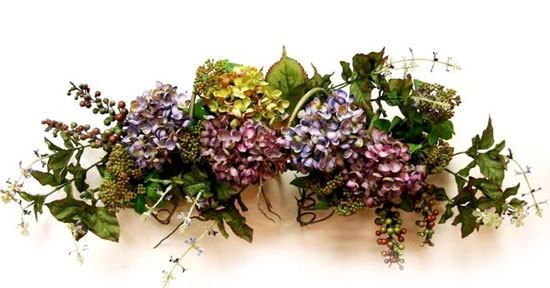
With summer being, sadly, halfway gone, it’s only natural for the intrepid crafter to start thinking of fall-themed projects. Here’s a wonderful one using the bounty from your summer garden. This how-to for a dried floral swag recommends using hydrangea and bittersweet, but you can substitute any flower and vine that air dries nicely, or just use dried florals.
Things you need:
24″ Natural Grapevine Swag
Floral wire
8 – Fresh, or dried, hydrangea blossoms
6 – Small branches of bittersweet
3 – Miniature pumpkins (Note: fresh pumpkins will have to be preserved by painting with two coats of varnish)
Wire cutter
Hot glue gun and glue sticks
Optional:
Stub wire
Long-nose pliers
Things to do:
1. When making floral swags, you’ll want to work with one type of floral at a time. Keeping the leaves intact, trim each hydrangea stem down to six inches. Insert the stems into the swag and hot glue them lightly into place so that the glue doesn’t show. If you prefer, you may use the floral wire instead of the hot glue, though in places you may need to use both. The swag will look better if you space the florals unevenly.
2. Distribute the bittersweet, throughout the swag, wrapping them around the hydrangea and letting the berry clusters hang out in front. Tuck any vine ends into the swag and hot glue them lightly so that the glue doesn’t show, or secure them with the floral wire.
3. Use the pumpkins to fill in any spaces and gaps. Apply hot glue liberally to the bottom of the pumpkins and immediately press into place. If you are using pumpkin picks, hot glue the pumpkin bottoms, but also carefully insert the picks into the garland and secure them with hot glue or floral wire.
4. Place the swag where air can circulate freely through the branches and allow it to dry completely.
Most pre-made grapevine swags are knotted in such a way as to provide a natural space to use for hanging. If you’re does not, you may use floral wire or stub wire to fashion a hanging wire in back using a pair of round nose pliers to carefully wrap the wire around the vines.